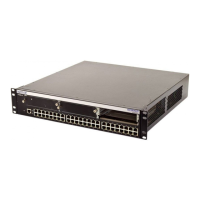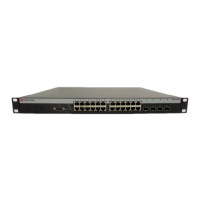Class of Service Configuration
3-157
3
CLI – This example assigns a default priority of 5 to port 3.
Mapping CoS Values to Egress Queues
This switch processes Class of Service (CoS) priority tagged traffic by using four
priority queues for each port, with service schedules based on Weighted Round
Robin (WRR). Up to 8 separate traffic priorities are defined in IEEE 802.1p. The
default priority levels are assigned according to recommendations in the IEEE
802.1p standard as shown in the following table.
The priority levels recommended in the IEEE 802.1p standard for various network
applications are shown in the following table. However, you can map the priority
levels to the switch’s output queues in any way that benefits application traffic for
your own network.
Console(config)#interface ethernet 1/3
Console(config-if)#switchport priority default 5 4-212
Console(config-if)#end
Console#show interfaces switchport ethernet 1/12 4-160
Information of Eth 1/12
Broadcast threshold: Enabled, 500 packets/second
LACP status: Disabled
Ingress rate limit: disable,100M bits per second
Egress rate limit: disable,100M bits per second
VLAN membership mode: Hybrid
Ingress rule: Disabled
Acceptable frame type: All frames
Native VLAN: 1
Priority for untagged traffic: 0
GVRP status: Enabled
Allowed VLAN: 1(u),
Forbidden VLAN:
Console#
Table 3-13. Egress Queue Priority Mapping
Queue 0123
Priority 1,2 0,3 4,5 6,7
Table 3-14. CoS Priority Levels
Priority Level Traffic Type
1 Background
2(Spare)
0 (default) Best Effort
3 Excellent Effort
4 Controlled Load
5 Video, less than 100 milliseconds latency and jitter
6 Voice, less than 10 milliseconds latency and jitter
7 Network Control

